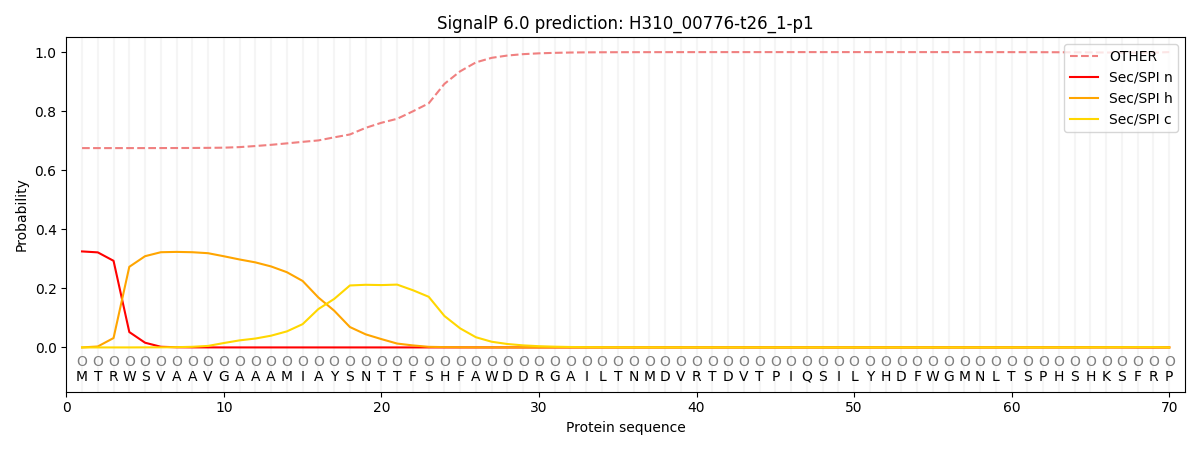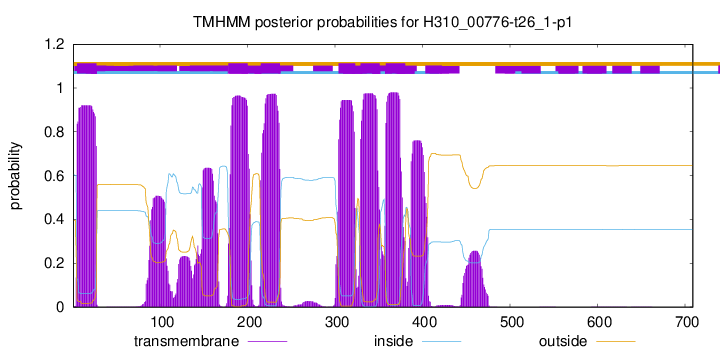You are browsing environment: FUNGIDB
CAZyme Information: H310_00776-t26_1-p1
You are here: Home > Sequence: H310_00776-t26_1-p1
Basic Information |
Genomic context |
Full Sequence |
Enzyme annotations |
CAZy signature domains |
CDD domains |
CAZyme hits |
PDB hits |
Swiss-Prot hits |
SignalP and Lipop annotations |
TMHMM annotations
Basic Information help
| Species | Aphanomyces invadans | |||||||||||
|---|---|---|---|---|---|---|---|---|---|---|---|---|
| Lineage | Oomycota; NA; ; Saprolegniaceae; Aphanomyces; Aphanomyces invadans | |||||||||||
| CAZyme ID | H310_00776-t26_1-p1 | |||||||||||
| CAZy Family | CBM48 | |||||||||||
| CAZyme Description | hypothetical protein, variant 1 | |||||||||||
| CAZyme Property |
|
|||||||||||
| Genome Property |
|
|||||||||||
| Gene Location | ||||||||||||
Enzyme Prediction help
| EC | 2.4.1.109:4 |
|---|
CAZyme Signature Domains help
| Family | Start | End | Evalue | family coverage |
|---|---|---|---|---|
| GT105 | 78 | 211 | 2.7e-33 | 0.9236641221374046 |
CDD Domains download full data without filtering help
| Cdd ID | Domain | E-Value | qStart | qEnd | sStart | sEnd | Domain Description |
|---|---|---|---|---|---|---|---|
| 400627 | DUF1736 | 4.92e-13 | 245 | 314 | 5 | 74 | Domain of unknown function (DUF1736). This domain of unknown function is found in various hypothetical metazoan proteins. |
| 276809 | TPR | 1.15e-07 | 412 | 490 | 17 | 97 | Tetratricopeptide repeat. The Tetratricopeptide repeat (TPR) typically contains 34 amino acids and is found in a variety of organisms including bacteria, cyanobacteria, yeast, fungi, plants, and humans. It is present in a variety of proteins including those involved in chaperone, cell-cycle, transcription, and protein transport complexes. The number of TPR motifs varies among proteins. Those containing 5-6 tandem repeats generate a right-handed helical structure with an amphipathic channel that is thought to accommodate an alpha-helix of a target protein. It has been proposed that TPR proteins preferentially interact with WD-40 repeat proteins, but in many instances several TPR-proteins seem to aggregate to multi-protein complexes. |
| 274350 | PEP_TPR_lipo | 2.95e-07 | 404 | 690 | 500 | 806 | putative PEP-CTERM system TPR-repeat lipoprotein. This protein family occurs in strictly within a subset of Gram-negative bacterial species with the proposed PEP-CTERM/exosortase system, analogous to the LPXTG/sortase system common in Gram-positive bacteria. This protein occurs in a species if and only if a transmembrane histidine kinase (TIGR02916) and a DNA-binding response regulator (TIGR02915) also occur. The present of tetratricopeptide repeats (TPR) suggests protein-protein interaction, possibly for the regulation of PEP-CTERM protein expression, since many PEP-CTERM proteins in these genomes are preceded by a proposed DNA binding site for the response regulator. |
| 276809 | TPR | 1.11e-06 | 429 | 507 | 1 | 81 | Tetratricopeptide repeat. The Tetratricopeptide repeat (TPR) typically contains 34 amino acids and is found in a variety of organisms including bacteria, cyanobacteria, yeast, fungi, plants, and humans. It is present in a variety of proteins including those involved in chaperone, cell-cycle, transcription, and protein transport complexes. The number of TPR motifs varies among proteins. Those containing 5-6 tandem repeats generate a right-handed helical structure with an amphipathic channel that is thought to accommodate an alpha-helix of a target protein. It has been proposed that TPR proteins preferentially interact with WD-40 repeat proteins, but in many instances several TPR-proteins seem to aggregate to multi-protein complexes. |
| 276809 | TPR | 1.30e-05 | 624 | 690 | 5 | 71 | Tetratricopeptide repeat. The Tetratricopeptide repeat (TPR) typically contains 34 amino acids and is found in a variety of organisms including bacteria, cyanobacteria, yeast, fungi, plants, and humans. It is present in a variety of proteins including those involved in chaperone, cell-cycle, transcription, and protein transport complexes. The number of TPR motifs varies among proteins. Those containing 5-6 tandem repeats generate a right-handed helical structure with an amphipathic channel that is thought to accommodate an alpha-helix of a target protein. It has been proposed that TPR proteins preferentially interact with WD-40 repeat proteins, but in many instances several TPR-proteins seem to aggregate to multi-protein complexes. |
CAZyme Hits help
| Hit ID | E-Value | Query Start | Query End | Hit Start | Hit End |
|---|---|---|---|---|---|
| 2.11e-65 | 4 | 449 | 21 | 502 | |
| 2.91e-65 | 4 | 449 | 21 | 502 | |
| 2.33e-63 | 4 | 437 | 20 | 490 | |
| 3.59e-63 | 17 | 496 | 19 | 514 | |
| 2.43e-62 | 4 | 437 | 20 | 490 |
Swiss-Prot Hits download full data without filtering help
| Hit ID | E-Value | Query Start | Query End | Hit Start | Hit End | Description |
|---|---|---|---|---|---|---|
| 5.17e-66 | 4 | 449 | 21 | 502 | Protein O-mannosyl-transferase TMTC4 OS=Homo sapiens OX=9606 GN=TMTC4 PE=1 SV=2 |
|
| 4.32e-63 | 4 | 437 | 20 | 490 | Protein O-mannosyl-transferase TMTC4 OS=Mus musculus OX=10090 GN=Tmtc4 PE=2 SV=1 |
|
| 2.50e-59 | 17 | 533 | 25 | 563 | Protein O-mannosyl-transferase TMTC3 OS=Mus musculus OX=10090 GN=Tmtc3 PE=1 SV=2 |
|
| 6.06e-59 | 17 | 533 | 20 | 558 | Protein O-mannosyl-transferase TMTC3 OS=Homo sapiens OX=9606 GN=TMTC3 PE=1 SV=2 |
|
| 3.96e-54 | 12 | 500 | 43 | 586 | Protein O-mannosyl-transferase Tmtc3 OS=Drosophila melanogaster OX=7227 GN=Tmtc3 PE=2 SV=1 |
SignalP and Lipop Annotations help
This protein is predicted as OTHER

| Other | SP_Sec_SPI | CS Position |
|---|---|---|
| 0.690236 | 0.309774 |
TMHMM Annotations download full data without filtering help

| Start | End |
|---|---|
| 5 | 27 |
| 178 | 200 |
| 215 | 237 |
| 304 | 323 |
| 329 | 351 |
| 358 | 380 |
